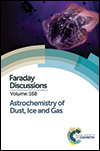Low-energy electron-induced chemistry of condensed methanol: implications for the interstellar synthesis of prebiotic molecules
Abstract
In the interstellar medium, UV photolysis of condensed methanol (CH3OH), contained in ice mantles surrounding dust grains, is thought to be the mechanism that drives the formation of “complex” molecules, such as methyl formate (HCOOCH3), dimethyl ether (CH3OCH3), acetic acid (CH3COOH), and glycolaldehyde (HOCH2CHO). The source of this reaction-initiating UV light is assumed to be local because externally sourced UV radiation cannot penetrate the ice-containing dark, dense molecular clouds. Specifically, exceedingly penetrative high-energy cosmic rays generate secondary electrons within the clouds through molecular ionizations. Hydrogen molecules, present within these dense molecular clouds, are excited in collisions with these secondary electrons. It is the UV light, emitted by these electronically excited hydrogen molecules, that is generally thought to photoprocess interstellar icy grain mantles to generate “complex” molecules. In addition to producing UV light, the large numbers of low-energy (<20 eV) secondary electrons, produced by cosmic rays, can also directly initiate radiolysis reactions in the condensed phase. The goal of our studies is to understand the low-energy, electron-induced processes that occur when high-energy cosmic rays interact with interstellar ices, in which methanol, a precursor of several prebiotic species, is the most abundant organic species. Using post-irradiation temperature-programmed desorption, we have investigated the radiolysis initiated by low-energy (7 eV and 20 eV) electrons in condensed methanol at ∼ 85 K under ultrahigh vacuum (5 × 10−10 Torr) conditions. We have identified eleven electron-induced methanol radiolysis products, which include many that have been previously identified as being formed by methanol UV photolysis in the interstellar medium. These experimental results suggest that low-energy, electron-induced condensed phase reactions may contribute to the interstellar synthesis of “complex” molecules previously thought to form exclusively via UV photons.
- This article is part of the themed collection: Astrochemistry of Dust, Ice and Gas

 Please wait while we load your content...
Please wait while we load your content...